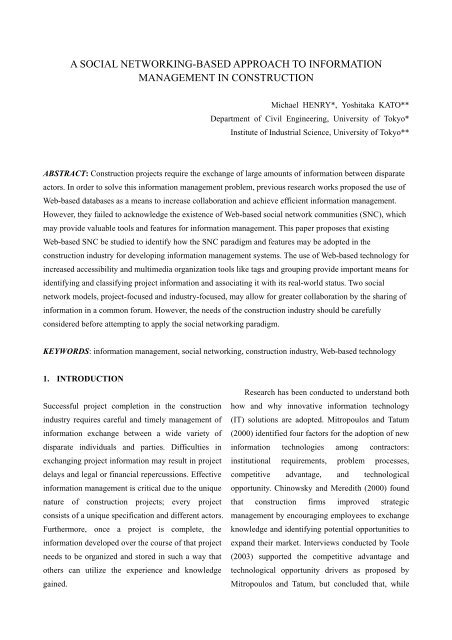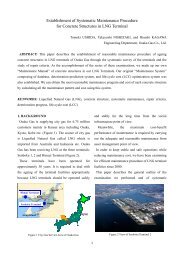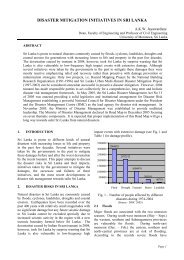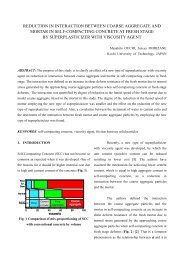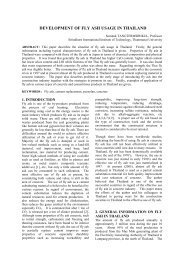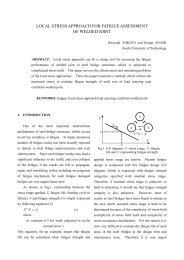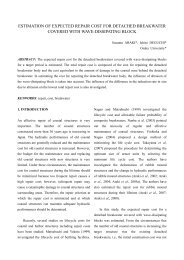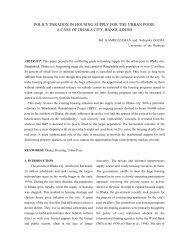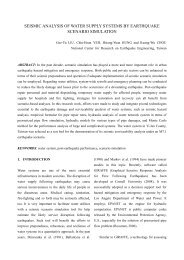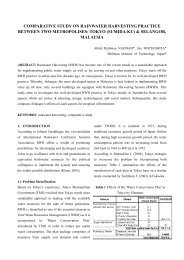PAPER FORMAT FOR THE INTERNATIONAL SYMPOSIUM on ...
PAPER FORMAT FOR THE INTERNATIONAL SYMPOSIUM on ...
PAPER FORMAT FOR THE INTERNATIONAL SYMPOSIUM on ...
Create successful ePaper yourself
Turn your PDF publications into a flip-book with our unique Google optimized e-Paper software.
A SOCIAL NETWORKING-BASED APPROACH TO IN<str<strong>on</strong>g><str<strong>on</strong>g>FOR</str<strong>on</strong>g>MAT</str<strong>on</strong>g>ION<br />
MANAGEMENT IN CONSTRUCTION<br />
Michael HENRY*, Yoshitaka KATO**<br />
Department of Civil Engineering, University of Tokyo*<br />
Institute of Industrial Science, University of Tokyo**<br />
ABSTRACT: C<strong>on</strong>structi<strong>on</strong> projects require the exchange of large amounts of informati<strong>on</strong> between disparate<br />
actors. In order to solve this informati<strong>on</strong> management problem, previous research works proposed the use of<br />
Web-based databases as a means to increase collaborati<strong>on</strong> and achieve efficient informati<strong>on</strong> management.<br />
However, they failed to acknowledge the existence of Web-based social network communities (SNC), which<br />
may provide valuable tools and features for informati<strong>on</strong> management. This paper proposes that existing<br />
Web-based SNC be studied to identify how the SNC paradigm and features may be adopted in the<br />
c<strong>on</strong>structi<strong>on</strong> industry for developing informati<strong>on</strong> management systems. The use of Web-based technology for<br />
increased accessibility and multimedia organizati<strong>on</strong> tools like tags and grouping provide important means for<br />
identifying and classifying project informati<strong>on</strong> and associating it with its real-world status. Two social<br />
network models, project-focused and industry-focused, may allow for greater collaborati<strong>on</strong> by the sharing of<br />
informati<strong>on</strong> in a comm<strong>on</strong> forum. However, the needs of the c<strong>on</strong>structi<strong>on</strong> industry should be carefully<br />
c<strong>on</strong>sidered before attempting to apply the social networking paradigm.<br />
KEYWORDS: informati<strong>on</strong> management, social networking, c<strong>on</strong>structi<strong>on</strong> industry, Web-based technology<br />
1. INTRODUCTION<br />
Successful project completi<strong>on</strong> in the c<strong>on</strong>structi<strong>on</strong><br />
industry requires careful and timely management of<br />
informati<strong>on</strong> exchange between a wide variety of<br />
disparate individuals and parties. Difficulties in<br />
exchanging project informati<strong>on</strong> may result in project<br />
delays and legal or financial repercussi<strong>on</strong>s. Effective<br />
informati<strong>on</strong> management is critical due to the unique<br />
nature of c<strong>on</strong>structi<strong>on</strong> projects; every project<br />
c<strong>on</strong>sists of a unique specificati<strong>on</strong> and different actors.<br />
Furthermore, <strong>on</strong>ce a project is complete, the<br />
informati<strong>on</strong> developed over the course of that project<br />
needs to be organized and stored in such a way that<br />
others can utilize the experience and knowledge<br />
gained.<br />
Research has been c<strong>on</strong>ducted to understand both<br />
how and why innovative informati<strong>on</strong> technology<br />
(IT) soluti<strong>on</strong>s are adopted. Mitropoulos and Tatum<br />
(2000) identified four factors for the adopti<strong>on</strong> of new<br />
informati<strong>on</strong> technologies am<strong>on</strong>g c<strong>on</strong>tractors:<br />
instituti<strong>on</strong>al requirements, problem processes,<br />
competitive advantage, and technological<br />
opportunity. Chinowsky and Meredith (2000) found<br />
that c<strong>on</strong>structi<strong>on</strong> firms improved strategic<br />
management by encouraging employees to exchange<br />
knowledge and identifying potential opportunities to<br />
expand their market. Interviews c<strong>on</strong>ducted by Toole<br />
(2003) supported the competitive advantage and<br />
technological opportunity drivers as proposed by<br />
Mitropoulos and Tatum, but c<strong>on</strong>cluded that, while
c<strong>on</strong>structi<strong>on</strong> c<strong>on</strong>tractors are applying IT soluti<strong>on</strong>s for<br />
informati<strong>on</strong> and knowledge transfer, IT was not<br />
being utilized for market and service expansi<strong>on</strong>.<br />
Furthermore, Toole made two important findings<br />
when surveying ten large c<strong>on</strong>structi<strong>on</strong> c<strong>on</strong>tractors.<br />
First, c<strong>on</strong>tractors expect Web-based technology for<br />
collaborati<strong>on</strong> between actors in a project to<br />
significantly impact the c<strong>on</strong>structi<strong>on</strong> industry, but<br />
that there will be resistance to such integrated IT<br />
soluti<strong>on</strong>s. Sec<strong>on</strong>d, the usefulness of mobile<br />
computing devices for the capture, storage, and<br />
transfer of project informati<strong>on</strong> over wireless<br />
networks will increase immensely, but the ability of<br />
firms to utilize these technologies is uncertain.<br />
The c<strong>on</strong>tinuing development of the Internet and<br />
the World Wide Web (WWW) has led to research <strong>on</strong><br />
the utilizati<strong>on</strong> of Web-based technologies for the<br />
c<strong>on</strong>structi<strong>on</strong> industry. Communicati<strong>on</strong> and<br />
informati<strong>on</strong> management systems for improving<br />
collaborati<strong>on</strong>, utilizing high-speed Web access;<br />
Internet tools like HTML, Java, scripting, FTP, and<br />
so forth; standardized data formats; and the<br />
increasing availability of wireless access and devices,<br />
have been proposed by researchers in the<br />
c<strong>on</strong>structi<strong>on</strong> engineering and management fields<br />
(Rojas and S<strong>on</strong>ger, 1999; Dawood, Akinsola, Hobbs,<br />
2002; Lee et al., 2003; Ariöz et al., 2007). These<br />
research works will be discussed in further detail in<br />
Secti<strong>on</strong> 2. However, they all propose a Web-based<br />
system for managing project informati<strong>on</strong> and/or<br />
uniting different project actors in a social network.<br />
While these research works are technically<br />
sound, what they fail to address is that a Web-based<br />
system for the organizati<strong>on</strong> and exchange of<br />
informati<strong>on</strong> between people already exists.<br />
Web-based social network communities (SNC) have<br />
grown significantly in popularity over the last few<br />
years. MySpace (www.myspace.com), Facebook<br />
(www.facebook.com), Hi5 (www.hi5.com),<br />
Friendster (www.friendster.com), Orkut<br />
(www.orkut.com), and Bebo (www.bebo.com) are<br />
examples of popular SNC, with a world-wide<br />
distributi<strong>on</strong> of users (comScore, 2007). These SNC<br />
functi<strong>on</strong> by providing a Web-based community for<br />
people who share interests and activities, and allow<br />
them to interact using comm<strong>on</strong> interfaces such as<br />
chat, messaging, email, and blogging; and the<br />
exchange of informati<strong>on</strong> by sharing files such as<br />
music, photos, videos, and so forth.<br />
1.1 Objectives<br />
This paper proposes the study of existing Web-based<br />
SNC in order to understand how this paradigm may<br />
be utilized for the development of informati<strong>on</strong><br />
management systems in the c<strong>on</strong>structi<strong>on</strong> industry.<br />
Understanding the technology behind these SNC is<br />
not as important as identifying how the c<strong>on</strong>structi<strong>on</strong><br />
industry can take advantage of the SNC paradigm.<br />
Many features of SNC may be useful for the<br />
c<strong>on</strong>structi<strong>on</strong> industry, and could be transferred<br />
directly, whereas some topics may require careful<br />
c<strong>on</strong>siderati<strong>on</strong> of the c<strong>on</strong>structi<strong>on</strong> industry’s needs<br />
before being adapted.<br />
2. PREVIOUS RESEARCH<br />
Four previous research works were identified as<br />
utilizing a Web-based approach for the management<br />
of project informati<strong>on</strong> or for establishing a social<br />
network for increasing informati<strong>on</strong> exchange and<br />
collaborati<strong>on</strong> in the c<strong>on</strong>structi<strong>on</strong> industry.<br />
2.1 Rojas and S<strong>on</strong>ger<br />
The use of Web-based technology for building a new<br />
method of collaborative engineering was proposed<br />
by Rojas and S<strong>on</strong>ger (1999). Their studied focused<br />
<strong>on</strong> the automati<strong>on</strong> of work flow by utilizing Web
tools so that users of the system would not need high<br />
computer literacy in order to operate the system. In<br />
order to measure the advantages a Web-based system<br />
could offer, they performed a case study by<br />
comparing the traditi<strong>on</strong>al, paper-based inspecti<strong>on</strong><br />
system with a prototype Web-based system. Their<br />
system combined software development, business<br />
process engineering, and workflow automati<strong>on</strong>.<br />
When comparing the paper-based and<br />
Web-based systems, Rojas and S<strong>on</strong>ger found there<br />
was a significant decrease in informati<strong>on</strong> processing<br />
costs associated with automating and digitizing the<br />
inspecti<strong>on</strong> results; this cost savings was balanced by<br />
the computer equipment expenses, resulting in a<br />
slightly lower total cost (per square foot) for the<br />
Web-based system. Mistakes were reduced in the<br />
Web-based system, which was attributed to the strict<br />
informati<strong>on</strong> processing procedure reducing human<br />
error. Service, defined as “the ability to produce<br />
useful informati<strong>on</strong> in a timely manner,” was also<br />
better for the Web-based system due to the ability of<br />
the digital database to produce any report<br />
instantaneously, any time of the day. However, while<br />
superior behavior for the Web-based system was<br />
shown in the case study, the authors identified some<br />
c<strong>on</strong>cerns with utilizing a Web-based system:<br />
technology integrati<strong>on</strong>, adopti<strong>on</strong> of the system by<br />
companies, and informati<strong>on</strong> security.<br />
2.2 Dawood et al.<br />
Dawood et al. (2002) proposed the development of<br />
an informati<strong>on</strong> management system for improving<br />
the coordinati<strong>on</strong>, distributi<strong>on</strong>, storage, and access of<br />
project informati<strong>on</strong>. This research focused <strong>on</strong><br />
communicati<strong>on</strong> of project informati<strong>on</strong> <strong>on</strong>-site during<br />
the c<strong>on</strong>structi<strong>on</strong> phase of a project, defining two key<br />
issues: understanding project producti<strong>on</strong> processes<br />
and the lack of a formal informati<strong>on</strong> and data sharing<br />
system. The authors investigated these issues by a<br />
process requirement analysis and modeling and<br />
system development.<br />
The developed system stored project files, which<br />
were available at any time for viewing, printing, or<br />
modificati<strong>on</strong>. Changes made to project specificati<strong>on</strong>s<br />
were immediately available to all project members,<br />
resulting in a large time savings. It also reduced<br />
costs by eliminating the need to produce paper<br />
copies of drawings. Overall, the system was found to<br />
provide time and costs savings relative to the<br />
traditi<strong>on</strong>al exchange of paper documents. It was<br />
c<strong>on</strong>cluded that optimizing the potential of IT<br />
resources may produce improvements in the<br />
c<strong>on</strong>structi<strong>on</strong> process.<br />
2.3 Lee et al.<br />
A Web-based model for the exchange of electr<strong>on</strong>ic<br />
informati<strong>on</strong> was proposed by Lee et al. (2003). They<br />
theorized that IT development and the increase in<br />
number of Web users may allow for the utilizati<strong>on</strong> of<br />
Web-based technologies for increasing collaborati<strong>on</strong><br />
am<strong>on</strong>g actors in a c<strong>on</strong>structi<strong>on</strong> project. This model<br />
was developed in three phases: study of c<strong>on</strong>structi<strong>on</strong><br />
documents work flow; analysis of existing electr<strong>on</strong>ic<br />
data interchange (EDI) models utilized in<br />
c<strong>on</strong>structi<strong>on</strong> projects; and the proposal of a<br />
Web-based EDI model based <strong>on</strong> the results of the<br />
previous two phases. Extensible markup language<br />
(XML), a Web-standard document form, was used<br />
for the standardizati<strong>on</strong> of informati<strong>on</strong> exchange.<br />
The authors found that c<strong>on</strong>structi<strong>on</strong> work<br />
documents should not <strong>on</strong>ly be classified by work<br />
scope, but also by the dimensi<strong>on</strong>s of the document<br />
itself, such as frequency of interchange, volume of<br />
informati<strong>on</strong>, and degree of formalizati<strong>on</strong>. Using<br />
these dimensi<strong>on</strong>s, the applicability of the XML/EDI<br />
model to each document could be examined, and the<br />
authors c<strong>on</strong>cluded that XML/EDI was appropriate
for documents with few figures, high degree of text<br />
descripti<strong>on</strong>, low volume, and high reference<br />
frequency. The use of a central database was then<br />
proposed as a Web-based XML/EDI model for<br />
managing users, document format and versi<strong>on</strong>, and<br />
informati<strong>on</strong> flow. The distributi<strong>on</strong> of documents is<br />
c<strong>on</strong>trolled by programmed processes; user details,<br />
such as authority, pers<strong>on</strong>al history, and so forth are<br />
all c<strong>on</strong>tained in the user database; any changes to the<br />
document database are sent to the users via the<br />
management module in the system. This system was<br />
designed to be run by a single company, such as the<br />
general c<strong>on</strong>tractor, who manages the c<strong>on</strong>structi<strong>on</strong><br />
project informati<strong>on</strong> and distributes it to the other<br />
project actors.<br />
2.4 Ariöz et al.<br />
Ariöz et al. (2007) applied Web-based technology to<br />
the m<strong>on</strong>itoring of c<strong>on</strong>crete quality in the ready<br />
mixed c<strong>on</strong>crete (RMC) industry. When using<br />
c<strong>on</strong>crete in a c<strong>on</strong>structi<strong>on</strong> project, the manufacturer<br />
provides the mix design, producti<strong>on</strong>, and<br />
transportati<strong>on</strong>; the customer is resp<strong>on</strong>sible for<br />
placing and curing. The system developed by the<br />
authors attempted to c<strong>on</strong>nect these two separate<br />
groups by checking the properties at different stages<br />
of the mixing and casting process and providing this<br />
informati<strong>on</strong> to the pertinent actors.<br />
This system primarily serves to improve the<br />
customer-manufacturer relati<strong>on</strong>ship. Customers can<br />
place orders <strong>on</strong>line; <strong>on</strong>ce received, the system<br />
checks the c<strong>on</strong>crete characteristics against the<br />
manufacturer specificati<strong>on</strong>s to ensure that the<br />
supplied material meets the customer’s needs.<br />
Transportati<strong>on</strong> data for the c<strong>on</strong>crete is entered by<br />
both the manufacturer and customer, as well as<br />
c<strong>on</strong>crete properties measured at the appropriate<br />
times. The system is also designed to provide a<br />
warning if any results fail to meet required standard<br />
values. Furthermore, mixing trucks can be tracked<br />
using general packet radio service (GPRS), and<br />
c<strong>on</strong>crete properties during transportati<strong>on</strong> can also be<br />
m<strong>on</strong>itored and changes made to the truck’s schedule<br />
as necessary based <strong>on</strong> the c<strong>on</strong>crete quality. By<br />
utilizing a Web-based database for managing and<br />
updating the material properties, the quality can be<br />
m<strong>on</strong>itored and c<strong>on</strong>trolled. The authors c<strong>on</strong>cluded<br />
that this system may reduce costs by c<strong>on</strong>trolling the<br />
product from order to delivery, as well as allowing<br />
the customer immediate access to all mix<br />
informati<strong>on</strong> via an Internet c<strong>on</strong>necti<strong>on</strong>.<br />
2.5 Previous research summary<br />
The four research works summarized here all<br />
utilized a Web-based approach in order to<br />
standardize and simplify the means for exchanging<br />
project informati<strong>on</strong>. By using a central computer<br />
database, data processes could be automated for<br />
reducing errors and increasing quality, and project<br />
informati<strong>on</strong> and documents could be made available<br />
for access to all project actors at any time, thus<br />
reducing delays and increasing cost savings.<br />
3. SNC FEATURES<br />
A social network is a structure composed of nodes<br />
c<strong>on</strong>nected to other nodes by some relati<strong>on</strong>ship or<br />
interdependency. Typically, these nodes represent<br />
individuals or groups of individuals, and the<br />
relati<strong>on</strong>ship is some value such as interest, friendship,<br />
financial transacti<strong>on</strong>, etc. Web-based social networks<br />
have grown around allowing a user to upload their<br />
informati<strong>on</strong> to a profile. Then, the user can establish<br />
ties to other users in the network based up<strong>on</strong><br />
whatever social c<strong>on</strong>necti<strong>on</strong> exists between them. In<br />
some cases, the two users may share a comm<strong>on</strong><br />
interest, thus creating a tie between the two nodes.<br />
Social networks may take a large variety of
forms, from the very simple (pers<strong>on</strong>al address book)<br />
to the sophisticated (Web-based SNC). They may<br />
also be for casual (again, Web-based SNC) or<br />
business (job hunting sites) use. In this paper,<br />
Web-based social networks were chosen due to the<br />
rapid growth and popularity which they have seen in<br />
recent years. Three categories of features will be<br />
presented: Web-based technology, informati<strong>on</strong><br />
organizati<strong>on</strong> and exchange, and user c<strong>on</strong>trol.<br />
3.1 Web-based technology<br />
The growth of the Web and the Internet has allowed<br />
for the ability to access data and make c<strong>on</strong>tacts<br />
instantaneously by utilizing the perpetual<br />
c<strong>on</strong>nectivity of the Web. Social networks have<br />
capitalized <strong>on</strong> this accessibility by providing an<br />
interactive structure in which users can provide<br />
up-to-the-minute informati<strong>on</strong> and distribute that<br />
informati<strong>on</strong> instantaneously to their friends and<br />
c<strong>on</strong>tacts. Furthermore, Web accessibility is growing<br />
as wireless networks and devices (such as<br />
next-generati<strong>on</strong> cellular ph<strong>on</strong>es) increase in number<br />
and sophisticati<strong>on</strong>. This in turn allows even more<br />
up-to-date informati<strong>on</strong> exchange, as the number of<br />
locati<strong>on</strong>s and means by which users can access the<br />
social network increases.<br />
Social network providers cannot c<strong>on</strong>trol the<br />
end-user; therefore, they have to ensure that the<br />
interface they provide is usable by any<strong>on</strong>e. Web<br />
scripting and programming languages, such as<br />
HTML and Java, are two ways which have been<br />
established as a comm<strong>on</strong> means for accessing Web<br />
c<strong>on</strong>tent. Ideally, Internet browsers are programmed<br />
to understand these languages without requiring any<br />
special software or download. Accessibility without<br />
complicated requirements is important for providing<br />
access to a large number of people with a wide<br />
diversity of abilities. Therefore, a simple, comm<strong>on</strong><br />
interface, such as that provided by the Web, is<br />
important when dealing with a user base of unknown<br />
capability.<br />
The importance of Web-based technology for<br />
assuring accessibility of informati<strong>on</strong> in the<br />
c<strong>on</strong>structi<strong>on</strong> industry has already been discussed in<br />
the surveyed research works. However, it’s<br />
important to menti<strong>on</strong> that using the standardized<br />
interface of the modern Web browser decreases the<br />
difficulty of integrating other companies into a social<br />
networking system.<br />
3.2 Informati<strong>on</strong> organizati<strong>on</strong> & exchange<br />
Users in SNC often share photos or videos between<br />
each other. In order to identify the c<strong>on</strong>tents of these<br />
media, tags are applied by the user. Tags are similar<br />
to keywords, in that they allow for the classificati<strong>on</strong><br />
and organizati<strong>on</strong> of media without surveying the<br />
entire c<strong>on</strong>tent of that media. These tags are, however,<br />
not limited just to categories or c<strong>on</strong>tents. People in<br />
videos or photos can be tagged by their name and<br />
have that tag c<strong>on</strong>nected to their user profile. This<br />
allows users who view the photos to make<br />
c<strong>on</strong>necti<strong>on</strong>s to other users. The informati<strong>on</strong> provided<br />
by users in their profile can also be viewed as a type<br />
of tagging. Data given in categories such as<br />
‘educati<strong>on</strong>,’ ‘interests,’ ‘activities,’ and so forth<br />
provide informati<strong>on</strong> which can be used to organize<br />
and classify the users themselves.<br />
Media can also be categorized or tagged by<br />
event. An event may be similar to a user profile, and<br />
represents some gathering of users, either in the real<br />
or digital world. In this case, the tie between users is<br />
the mutual attendance of the event. Event<br />
informati<strong>on</strong>, such as time and locati<strong>on</strong>, as well as<br />
media can be uploaded and tied to the event.<br />
Applying tags to media allows for the<br />
organizati<strong>on</strong> or grouping of different forms of media
ased <strong>on</strong> a given search topic or selecti<strong>on</strong>. In social<br />
networks, grouping is a basic way of finding other<br />
users who share similar characteristics, or gathering<br />
disparate types of media together based <strong>on</strong> a single<br />
comm<strong>on</strong> theme. As menti<strong>on</strong>ed previously, media can<br />
be organized by date or time as well; this adds<br />
another dimensi<strong>on</strong> to media organizati<strong>on</strong>.<br />
For the c<strong>on</strong>structi<strong>on</strong> industry, being able to<br />
quickly and efficiently organize users, media, and so<br />
forth, based <strong>on</strong> temporal, geographic, c<strong>on</strong>tent, or<br />
other dimensi<strong>on</strong>al specificati<strong>on</strong>s would be beneficial<br />
for managing informati<strong>on</strong> in a c<strong>on</strong>structi<strong>on</strong> project.<br />
By utilizing <strong>on</strong>line computer databases for storing<br />
users, media, and their attached metadata, the ability<br />
to organize and group would be limited <strong>on</strong>ly by<br />
storage space and processing power. Furthermore, as<br />
menti<strong>on</strong>ed in Rojas and S<strong>on</strong>ger, computer-managed<br />
databases can organize and disseminate informati<strong>on</strong><br />
faster, more efficiently, and with fewer errors than a<br />
human-managed system.<br />
3.3 User c<strong>on</strong>trol<br />
The ways in which SNC have given c<strong>on</strong>trol to the<br />
network users has been, in part, driven by the need to<br />
ensure privacy. Social network users provide<br />
pers<strong>on</strong>al informati<strong>on</strong>, but they may not want that<br />
informati<strong>on</strong> available to everybody <strong>on</strong> the network.<br />
Hence the development of privacy c<strong>on</strong>trols, which<br />
allow users the power to approve who sees their<br />
informati<strong>on</strong>, as well as how much informati<strong>on</strong> is<br />
viewable. Informati<strong>on</strong> c<strong>on</strong>trol, with relati<strong>on</strong> to the<br />
c<strong>on</strong>structi<strong>on</strong> industry paradigm, will be discussed<br />
further in Secti<strong>on</strong> 4.1.<br />
3.4 Example utilizing SNC features<br />
A simple, c<strong>on</strong>ceptual social network model for a<br />
c<strong>on</strong>structi<strong>on</strong> project was built using the informati<strong>on</strong><br />
organizati<strong>on</strong> and exchange features in Secti<strong>on</strong> 3.2.<br />
This model, shown in Figure 1, assumes the<br />
c<strong>on</strong>structi<strong>on</strong> “project” as the core feature. Within the<br />
project, there are several sub-categories: project<br />
informati<strong>on</strong>, users, media, events, and updates.<br />
Details about the project are given in the<br />
“informati<strong>on</strong>” sub-category. General informati<strong>on</strong><br />
about the project, such as locati<strong>on</strong>, descripti<strong>on</strong>, and<br />
scope, is stored here. Since “informati<strong>on</strong>” is a<br />
sub-category of “project,” any informati<strong>on</strong> stored<br />
here is directly related to the project.<br />
The participating project members are given in<br />
the “users” sub-category. In this group, the different<br />
roles of the project can be filled by users, such as<br />
owner, architect, or inspector. Each of these users<br />
then has a “user profile,” which is used to provide<br />
informati<strong>on</strong> about that user. The “activity”<br />
sub-category is used to track any acti<strong>on</strong>s of the user;<br />
if the user is identified in another set of data, then<br />
that informati<strong>on</strong> will be related back to the user’s<br />
profile. The “employment” sub-category is like a<br />
digital business card stored in the social network.<br />
The “media” sub-category is the storage space<br />
for all digital files related to the project. Media<br />
uploaded to the project is accompanied by<br />
identifying metadata, such as the uploading user,<br />
tags (or keywords), a brief descripti<strong>on</strong> of the media<br />
c<strong>on</strong>tents, the event to which the media relates, and so<br />
forth. Once this informati<strong>on</strong> is stored in the database,<br />
the media can be related back to the user and/or<br />
event.<br />
The “event” sub-category is a virtual calendar<br />
which stores informati<strong>on</strong> about project events. The<br />
timeline is a master calendar which holds all the<br />
dates and their related events; each event has its own<br />
related informati<strong>on</strong> such as date, locati<strong>on</strong>,<br />
descripti<strong>on</strong>, related media, and attending users. After<br />
an event has occurred, data can be uploaded into the
PROJECT<br />
+name<br />
IN<str<strong>on</strong>g><str<strong>on</strong>g>FOR</str<strong>on</strong>g>MAT</str<strong>on</strong>g>ION<br />
USERS<br />
MEDIA<br />
EVENTS<br />
UPDATES<br />
+locati<strong>on</strong><br />
+owner<br />
+documents<br />
+timeline<br />
+recent uploads<br />
+project type<br />
+architect<br />
+photos<br />
+upcoming events<br />
+recent events<br />
+descripti<strong>on</strong><br />
+designer<br />
+videos<br />
+…<br />
+recent changes<br />
+…<br />
+c<strong>on</strong>tractor<br />
+drawings<br />
+…<br />
+inspector<br />
+…<br />
+…<br />
TIMELINE<br />
USER PROFILE<br />
+name<br />
+project role<br />
+…<br />
Uploads<br />
media<br />
UPLOAD<br />
+uploading user<br />
+keywords<br />
+descripti<strong>on</strong><br />
+related event<br />
+date1:event1<br />
+date2:event2<br />
+…<br />
Media uploaded<br />
+…<br />
EVENT INFO<br />
EMPLOYMENT<br />
+company<br />
ACTIVITY<br />
+uploaded media<br />
Related event<br />
+date<br />
+locati<strong>on</strong><br />
+descripti<strong>on</strong><br />
+positi<strong>on</strong><br />
+descripti<strong>on</strong><br />
+locati<strong>on</strong><br />
+events attended<br />
+changes made<br />
+…<br />
Uploaded media<br />
+related media<br />
+attending users<br />
+…<br />
Events occurred<br />
+c<strong>on</strong>tact<br />
+…<br />
Event attended<br />
Attends event<br />
Figure 1 C<strong>on</strong>ceptual model of the c<strong>on</strong>structi<strong>on</strong> project as a social network<br />
database – media and user attendance, for example –<br />
and this informati<strong>on</strong> will be tied to the related media<br />
or user profile.<br />
The final sub-category is “updates.” This<br />
sub-category is a database which records the most<br />
recent changes to the project system and provides<br />
that informati<strong>on</strong> to the users.<br />
own social networks by integrating and expanding<br />
their standard email services (Hansell, 2007). As<br />
emails represent the c<strong>on</strong>necti<strong>on</strong>s between people, the<br />
email providers already have the framework for<br />
establishing a SNC. Other features, such as<br />
organizing emails by relati<strong>on</strong>ship strength,<br />
displaying profiles of email corresp<strong>on</strong>dents, and a<br />
news feed with status updates from friends, are all<br />
inspired by the social networking paradigm.<br />
4. ADOPTING <str<strong>on</strong>g>THE</str<strong>on</strong>g> SNC PARADIGM<br />
The social networking paradigm itself is<br />
Features of SNC and the social networking paradigm<br />
are already being adopted for other applicati<strong>on</strong>s and<br />
industries. Most notably, major email providers such<br />
as Google and Yahoo are attempting to develop their<br />
c<strong>on</strong>stantly changing as different networks compete<br />
to provide the best service and attract more users.<br />
Facebook garnered a lot of attenti<strong>on</strong> for allowing<br />
outside developers to build programs which can be
integrated into the Facebook system and made<br />
available to users (The Ec<strong>on</strong>omist, 2007). Google<br />
and MySpace are also c<strong>on</strong>sidering such a move in<br />
order to compete with the Facebook model<br />
(Gershberg, 2007).<br />
4.1 SNC for the c<strong>on</strong>structi<strong>on</strong> industry<br />
While the social networking paradigm and its<br />
features have already been covered, the questi<strong>on</strong> of<br />
how to adopt these for applicati<strong>on</strong> to the c<strong>on</strong>structi<strong>on</strong><br />
industry has yet to be discussed. C<strong>on</strong>siderati<strong>on</strong> must<br />
be given to how the c<strong>on</strong>structi<strong>on</strong> industry operates,<br />
and how SNC features can be applied to help solve<br />
informati<strong>on</strong> management problems.<br />
Social networking could c<strong>on</strong>ceptually be applied<br />
in two ways. The first is project-focused. In this<br />
model, the social network is built around a<br />
c<strong>on</strong>structi<strong>on</strong> project; the actors are the project<br />
participants, and the informati<strong>on</strong> to be exchanged<br />
bel<strong>on</strong>gs to the project. User interacti<strong>on</strong> is purely<br />
within the bounds of the project scope. The sec<strong>on</strong>d<br />
model is a professi<strong>on</strong>al social network for the<br />
c<strong>on</strong>structi<strong>on</strong> industry. This model may be utilized for<br />
the sharing of experience, new ideas or techniques,<br />
and would act as a forum for establishing<br />
professi<strong>on</strong>al ties and increasing collaborati<strong>on</strong><br />
between different members of the c<strong>on</strong>structi<strong>on</strong><br />
community. In this case, the informati<strong>on</strong> exchanged<br />
may be related more to the users. The research works<br />
surveyed in Secti<strong>on</strong> 2, as well as the c<strong>on</strong>ceptual<br />
model given in Figure 1, are of the former social<br />
network model. In the latter model, the social ties are<br />
established by the users themselves, which is more<br />
similar to existing Web-based SNC, and may be<br />
based <strong>on</strong> field, pers<strong>on</strong>al or research interests, and so<br />
forth.<br />
Informati<strong>on</strong> c<strong>on</strong>trol requires c<strong>on</strong>siderati<strong>on</strong> when<br />
proposing the adopti<strong>on</strong> of social networking. In the<br />
Web-based SNC model, informati<strong>on</strong> is c<strong>on</strong>trolled by<br />
each individual user, who can choose how much to<br />
share and with whom. Assuming the c<strong>on</strong>structi<strong>on</strong><br />
project as a social network, the exchange of<br />
informati<strong>on</strong> may not be decided by each user, but<br />
restricted by legal or c<strong>on</strong>tractual guidelines. Previous<br />
research works have already shown that there is a<br />
flow to informati<strong>on</strong> in c<strong>on</strong>structi<strong>on</strong> projects.<br />
Therefore, any social networking system would need<br />
to be programmed to follow the legal structure<br />
established by the c<strong>on</strong>tract documents.<br />
Informati<strong>on</strong> security in a c<strong>on</strong>structi<strong>on</strong> project is<br />
vital in order to protect the interests and investment<br />
of the parties involved. Other industries have already<br />
provided Web access to secure informati<strong>on</strong> for their<br />
customers, so they have discovered the<br />
vulnerabilities in adopting the Web paradigm and are<br />
c<strong>on</strong>tinually readjusting their services to account for<br />
new security threats. As the Web paradigm is<br />
relatively new to the c<strong>on</strong>structi<strong>on</strong> industry, problems<br />
relating to informati<strong>on</strong> security are not entirely clear.<br />
However, research into the problems experienced by<br />
other industries, combined with an investigati<strong>on</strong> of<br />
the needs for the c<strong>on</strong>structi<strong>on</strong> industry, would<br />
provide necessary background informati<strong>on</strong> for<br />
developing security in informati<strong>on</strong> management<br />
systems.<br />
4.2 C<strong>on</strong>cerns with social networking<br />
Even though the popularity of social networking is<br />
growing rapidly and many companies are investing<br />
in the technology to increase their social networking<br />
strength, the SNC paradigm may not be appropriate<br />
for all businesses. While the c<strong>on</strong>structi<strong>on</strong> industry<br />
appears to be an ideal applicati<strong>on</strong> for social<br />
networking, its specific needs should be further<br />
studied in order to verify how to properly adopt this<br />
developing technology.
5. CONCLUSIONS<br />
A survey of the past research works found that using<br />
a Web-based database and interface reduced<br />
mistakes and increased accessibility, which resulted<br />
in reduced project costs. However, these works did<br />
not acknowledge the paradigm for social networking<br />
establish by Web-based SNC. This paper proposed<br />
the study of Web-based SNC for the development of<br />
informati<strong>on</strong> management systems for the<br />
c<strong>on</strong>structi<strong>on</strong> industry.<br />
need to be performed to understand the relati<strong>on</strong>ship<br />
between informati<strong>on</strong> flow and c<strong>on</strong>trol and<br />
c<strong>on</strong>tractual agreements. Such studies should also<br />
investigate the importance of informati<strong>on</strong> security in<br />
the c<strong>on</strong>structi<strong>on</strong> industry. While other industries<br />
have already adopted the Internet as a means for<br />
exchanging informati<strong>on</strong>, the c<strong>on</strong>structi<strong>on</strong> industry<br />
does not have such experience. Therefore,<br />
background informati<strong>on</strong> should be gathered to<br />
clarify the role of security when developing an<br />
informati<strong>on</strong> management system.<br />
Web-based SNC allow users to interact through<br />
a comm<strong>on</strong> interface anywhere they can access the<br />
Internet, at any time. In order to create a simple and<br />
intuitive means for these users to share data, tools<br />
were developed for the organizati<strong>on</strong> and exchange of<br />
informati<strong>on</strong>. Tags are a means of labeling the<br />
c<strong>on</strong>tents of any type of media, allowing users to<br />
generally know the c<strong>on</strong>tents of a file without having<br />
to survey the entire file. Tags can be more than just<br />
keywords, though – they can also be users or events.<br />
Organizing data by using tags allows for the quick<br />
grouping of any type of informati<strong>on</strong> which is<br />
identified by a given tag. A c<strong>on</strong>ceptual model of the<br />
c<strong>on</strong>structi<strong>on</strong> project as a social network was<br />
developed using these tools for the management of<br />
informati<strong>on</strong>.<br />
While these tools may be easily utilized by the<br />
c<strong>on</strong>structi<strong>on</strong> industry, other features of the SNC<br />
paradigm cannot be easily transferred. Informati<strong>on</strong><br />
c<strong>on</strong>trol is an important part of effective c<strong>on</strong>structi<strong>on</strong><br />
management. In the normal SNC paradigm,<br />
informati<strong>on</strong> flow is generally free, restricted <strong>on</strong>ly by<br />
user c<strong>on</strong>trols <strong>on</strong> privacy. However, <strong>on</strong> a c<strong>on</strong>structi<strong>on</strong><br />
project, informati<strong>on</strong> flow may be dictated by<br />
c<strong>on</strong>tractual or legal requirements. Therefore, c<strong>on</strong>trols<br />
need to be established to respect the legal structure<br />
of the c<strong>on</strong>tract. To develop these c<strong>on</strong>trols, studies<br />
There are two ways in which social networking<br />
could be adopted by the c<strong>on</strong>structi<strong>on</strong> industry. The<br />
first model uses the c<strong>on</strong>structi<strong>on</strong> project as the tie<br />
between actors in a network; informati<strong>on</strong> exchange<br />
in this model is restricted to that relating to the<br />
project. In the sec<strong>on</strong>d model, the social network<br />
encompasses the field of c<strong>on</strong>structi<strong>on</strong>; the role of<br />
informati<strong>on</strong> and management exchange is for the<br />
enhancement of industry knowledge and increased<br />
collaborati<strong>on</strong>.<br />
Regardless of which social networking model is<br />
adopted, the applicability of the SNC paradigm for<br />
c<strong>on</strong>structi<strong>on</strong> should be thoroughly investigated and<br />
understood. As indicated by past studies, c<strong>on</strong>tractors<br />
are hesitant to adopt new IT technologies; therefore,<br />
the benefits and problems of this paradigm for<br />
managing informati<strong>on</strong> should be made clear before<br />
practical adopti<strong>on</strong> of the model by the industry.<br />
REFERENCES<br />
Ariöz, Ö., Arslan, G., Tuncan, M., Kivrak, S., 2007.<br />
Web-based quality c<strong>on</strong>trol of ready mixed c<strong>on</strong>crete,<br />
Elsevier Building and Envir<strong>on</strong>ment, 42:1465-1470.<br />
Chinowsky, P.S. and Meredith, J.E., 2000. Strategic<br />
Management in c<strong>on</strong>structi<strong>on</strong>, ASCE Journal of
C<strong>on</strong>structi<strong>on</strong> Engineering and Management,<br />
126(1):1-9.<br />
Integrati<strong>on</strong> and Innovati<strong>on</strong> of C<strong>on</strong>structi<strong>on</strong>, Hawaii,<br />
2003.<br />
comScore, 2007. Social networking goes global,<br />
comScore press release, URL:<br />
http://www.comscore.com/press/release.asp?press=1<br />
555 (last date accessed: 30 Jan. 2008).<br />
Mitropoulos, P. and Tatum, C.B., 2000. Forces<br />
driving adopti<strong>on</strong> of new informati<strong>on</strong> technologies,<br />
ASCE Journal of C<strong>on</strong>structi<strong>on</strong> Engineering and<br />
Management, 127(5):340-348.<br />
Dawood, N., Akinsola, A., Hobbs, B., 2002.<br />
Development of automated communicati<strong>on</strong> of<br />
system for managing site informati<strong>on</strong> using internet<br />
technology, Elsevier Automati<strong>on</strong> in C<strong>on</strong>structi<strong>on</strong><br />
11:557-572.<br />
Rojas, E.M. and S<strong>on</strong>ger, A.D., 1999. Web-centric<br />
systems: a new paradigm for collaborative<br />
engineering, ASCE Journal of Management in<br />
Engineering, 15(1):39-45.<br />
The Ec<strong>on</strong>omist, 2007. Social graph-iti, The<br />
Ec<strong>on</strong>omist Business article, URL:<br />
http://www.ec<strong>on</strong>omist.com/business/displaystory.cf<br />
m?story_id=9990635 (last date accessed: 6 Feb.<br />
2008).<br />
Toole, T.M., Informati<strong>on</strong> technology innovati<strong>on</strong>: a<br />
view of large c<strong>on</strong>tractors, Proceedings of ASCE<br />
C<strong>on</strong>structi<strong>on</strong> Research C<strong>on</strong>gress, Winds of Change:<br />
Integrati<strong>on</strong> and Innovati<strong>on</strong> of C<strong>on</strong>structi<strong>on</strong>, Hawaii,<br />
2003.<br />
Gershberg, M., 2007. Google opens doors to social<br />
networking, Reuters Technology article, URL:<br />
http://www.reuters.com/article/technologyNews/idU<br />
SN3043165520071031 (last date accessed: 4 Feb.<br />
2008).<br />
Hansell, S., 2007. Yahoo and Google to turn e-mail<br />
into a social network, New York Times Technology<br />
Blog, URL:<br />
http://bits.blogs.nytimes.com/2007/11/13/inbox-20-y<br />
ahoo-and-google-to-turn-e-mail-into-a-social-networ<br />
k/index.html?ex=1352696400&en=b7f0d6a896f23b<br />
ec&ei=5088&partner=rssnyt&emc=rss (last date<br />
accessed: 4 Feb. 2008).<br />
Lee, H.S., An, S.J., S<strong>on</strong>, B.S., Jang, M.H., Choi, Y.K.,<br />
Web-based electr<strong>on</strong>ic data interchange model to<br />
improve the collaborati<strong>on</strong> of participants in<br />
c<strong>on</strong>structi<strong>on</strong> projects, Proceedings of ASCE<br />
C<strong>on</strong>structi<strong>on</strong> Research C<strong>on</strong>gress, Winds of Change:


